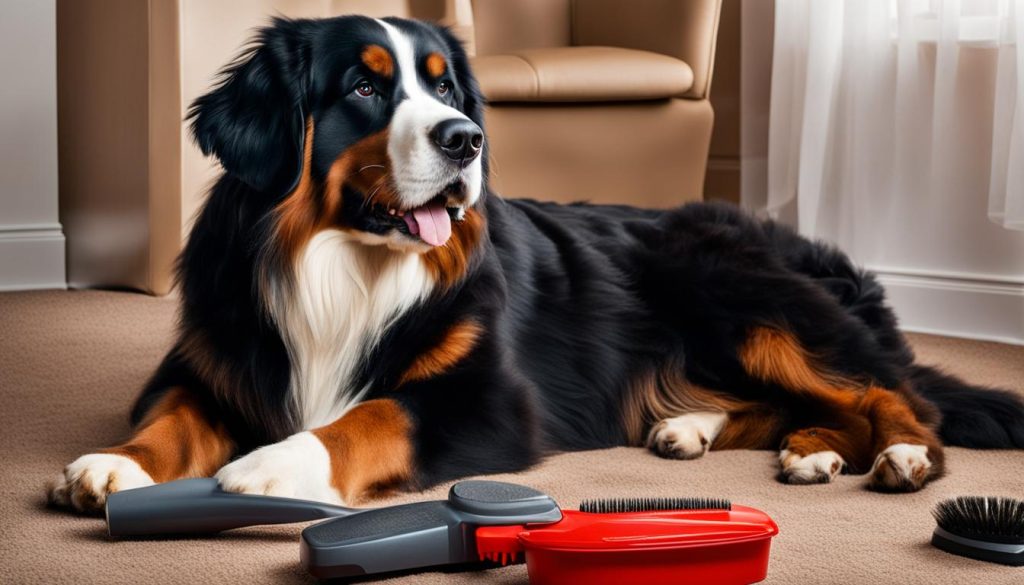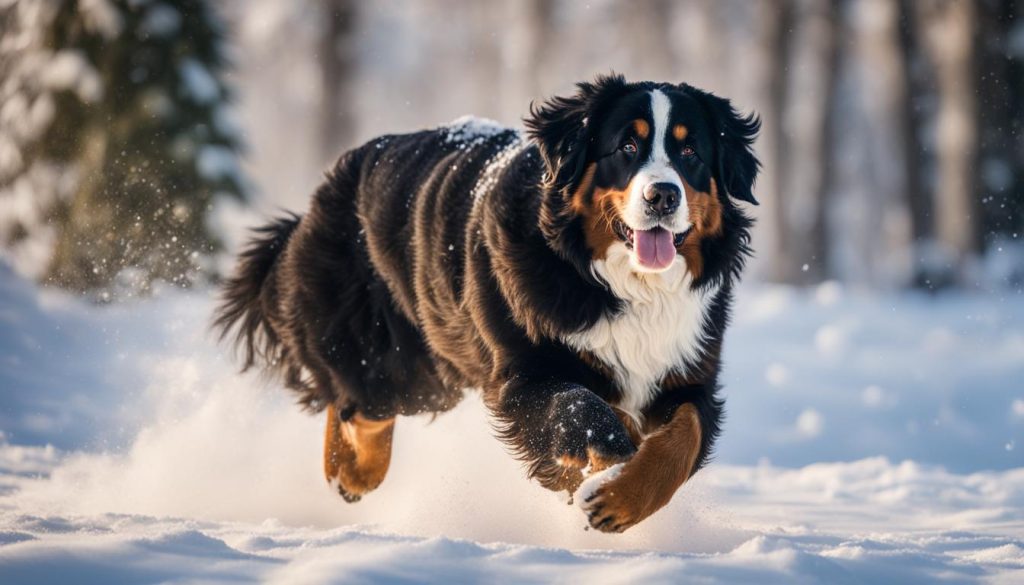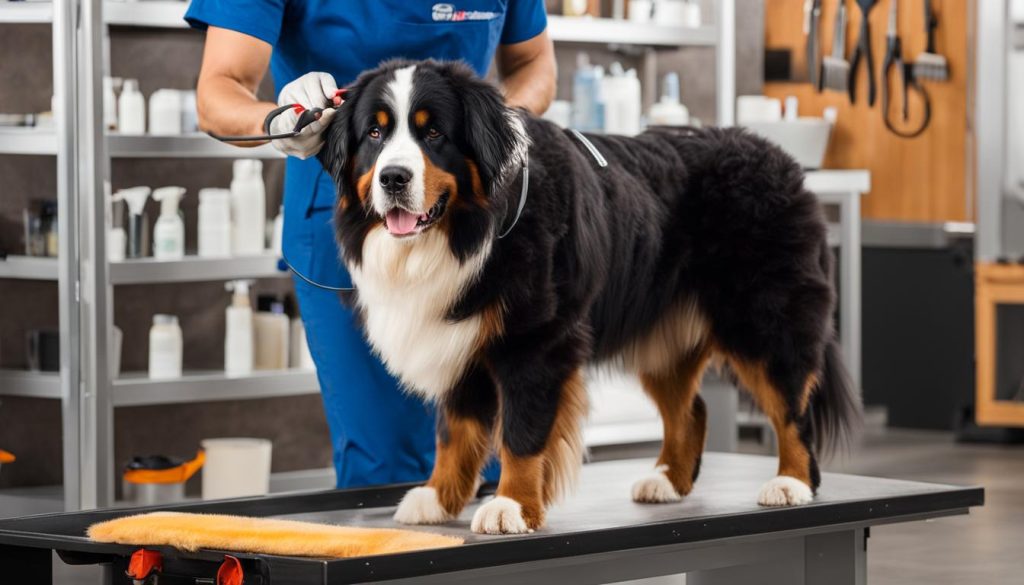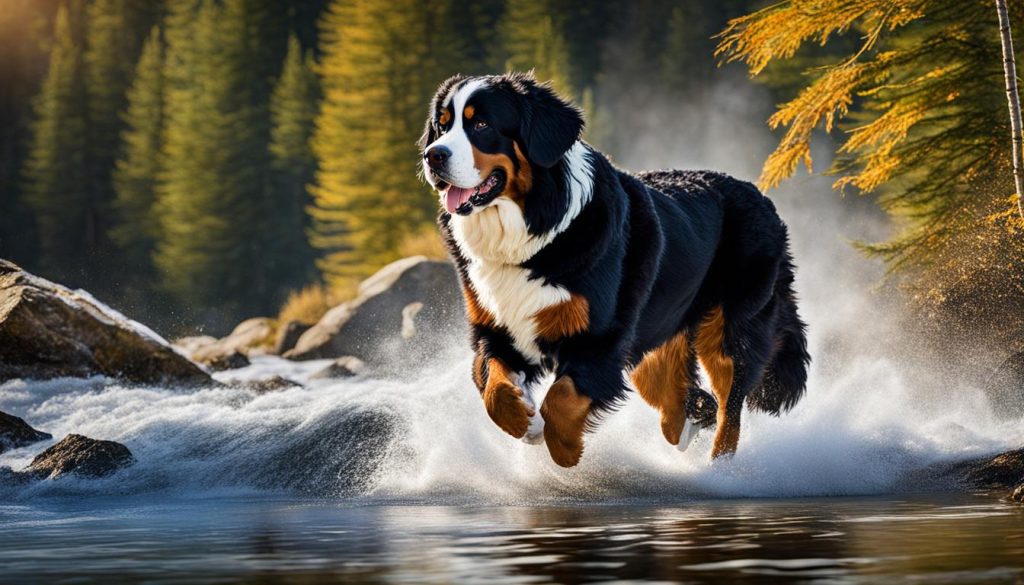Bernese Mountain Dogs are known for their beautiful and majestic appearance. With their thick double coat, they are well-equipped to handle cold weather. However, this also means that they shed quite a lot of hair. If you are considering getting a Bernese Mountain Dog, it’s important to understand the shedding challenges that come with this breed.
Regular grooming and brushing can help manage the shedding, but it is something that owners need to be prepared for. In this article, we will explore the shedding habits of Bernese Mountain Dogs, the challenges of owning them, and provide tips on how to effectively manage their shedding.
Key Takeaways:
- Bernese Mountain Dogs shed a lot due to their thick double coat.
- Regular grooming and brushing can help manage their shedding.
- Investing in a good vacuum cleaner and using the right brushes can make managing their shedding easier.
- Proper diet and regular exercise can contribute to a healthy coat and potentially reduce shedding.
- Despite their shedding, Bernese Mountain Dogs are loyal and affectionate companions.
The Challenges of Owning a Bernese Mountain Dog
Bernese Mountain Dogs present unique challenges for their owners, primarily due to their shedding and grooming requirements. They are known to shed a lot, so if you have a preference for a hair-free home, this breed may not be the best fit for you. Their thick double coat not only contributes to shedding but also requires regular grooming to prevent matting and hair loss.
Grooming a Bernese Mountain Dog can be a time-consuming task. The coat should be brushed regularly to remove loose hair and prevent tangles. A combination of a pin brush and slicker brush is recommended for effective grooming. It’s important to note that their shedding is not limited to specific seasons; they shed year-round, although shedding tends to be more pronounced during certain times of the year.
Aside from shedding and grooming, Bernese Mountain Dogs also require adequate exercise and mental stimulation. They are a larger breed and need regular physical activity to maintain their health and prevent obesity. A lack of exercise can lead to behavior problems, so it’s essential to provide them with opportunities for exercise and play.
“Owning a Bernese Mountain Dog requires dedication and commitment to their grooming needs and exercise requirements. Prospective owners should be prepared for the challenges that come with managing shedding and providing sufficient mental and physical stimulation.”
Table: Pros and Cons of Owning a Bernese Mountain Dog
| Pros | Cons |
|---|---|
| Loyal and affectionate | Shedding |
| Good with children | Grooming requirements |
| Natural watchdog instincts | Exercise needs |
| Intelligent and trainable | Larger size |
Owning a Bernese Mountain Dog can be a rewarding experience, but it’s important to consider the challenges they present. With proper care, grooming, and exercise, they can thrive and make a wonderful addition to a loving home.
Tips for Managing Shedding in Bernese Mountain Dogs

To manage shedding in Bernese Mountain Dogs, there are several tips and techniques that can be helpful. Regular grooming and brushing, choosing the right brushes, and using proper cleaning methods can all contribute to controlling shedding and maintaining a clean environment. Here are some key tips:
1. Regular Grooming and Brushing
Grooming is crucial for managing shedding in Bernese Mountain Dogs. Regular brushing helps remove loose hair, prevent mats, and distribute natural oils throughout their coat. Aim to brush your dog’s coat at least 3-4 times a week, especially during shedding seasons. This will help keep their coat healthy and minimize shedding.
2. Best Brushes for Bernese Mountain Dogs
Choosing the right brushes is essential for effective grooming. A combination of a pin brush and slicker brush is recommended for Bernese Mountain Dogs. The pin brush helps remove tangles and loose hair, while the slicker brush is effective in removing dead hair and preventing mats. Using these brushes regularly will help control shedding and maintain a well-groomed coat.
3. Tips to Control Shedding
In addition to grooming and brushing, there are other tips to help control shedding in Bernese Mountain Dogs. Regular bathing and grooming can keep their coat clean and tangle-free. It is also important to provide a high-quality diet that includes essential fatty acids, as this can promote a healthy coat and potentially reduce shedding. Lastly, regular exercise is beneficial for overall coat health and can help minimize shedding.
| Grooming Tip | Description |
|---|---|
| Regular brushing | Brush your Bernese Mountain Dog’s coat 3-4 times a week to remove loose hair and prevent mats. |
| Use the right brushes | Use a combination pin brush and slicker brush to effectively remove tangles and dead hair. |
| Regular bathing and grooming | Keep your dog’s coat clean and tangle-free by regularly bathing and grooming them. |
| Provide a high-quality diet | Feed your dog a diet that includes essential fatty acids to promote a healthy coat and potentially reduce shedding. |
| Regular exercise | Ensure your Bernese Mountain Dog gets regular exercise to maintain overall coat health and minimize shedding. |
By following these tips and incorporating them into your routine, you can effectively manage shedding in Bernese Mountain Dogs and keep their coat healthy and well-maintained.
Why Do Bernese Mountain Dogs Shed So Much?
Bernese Mountain Dogs are known for shedding a lot due to their thick double coat. This coat is designed to protect them from the cold weather in their native Swiss Alps, but it also means that they shed heavily throughout the year. The shedding is especially noticeable in the spring and summer when they shed their undercoat to adapt to warmer temperatures.
The shedding in Bernese Mountain Dogs is a natural process, but there are a few reasons why they shed so much. Firstly, their coat is made up of both an outer coat and an undercoat. The undercoat is soft and dense, providing insulation, while the outer coat is longer and coarser. Both layers of fur shed throughout the year, with the undercoat shedding more heavily during seasonal changes.
Secondly, diet and genetics can also play a role in shedding. Bernese Mountain Dogs with a healthy diet that includes essential fatty acids are more likely to have a healthier coat, which may result in less shedding. Additionally, the amount of shedding can vary from dog to dog, depending on their genetic makeup and individual characteristics.
If you find that your Bernese Mountain Dog is shedding excessively or experiencing hair loss, it is important to consult with a veterinarian. Excessive shedding can sometimes be a sign of an underlying health issue, such as allergies or hormonal imbalances. A vet will be able to assess your dog’s condition and provide appropriate guidance and treatment if necessary.
| Reasons for Bernese Mountain Dog Shedding | Solutions |
|---|---|
| Thick double coat | Regular grooming and brushing |
| Seasonal shedding | Manage shedding with appropriate grooming tools |
| Diet and genetics | Feed a high-quality diet with essential fatty acids |
| Possible underlying health issues | Consult with a veterinarian for proper diagnosis and treatment |
How to Reduce Shedding in Bernese Mountain Dogs

Reducing shedding in Bernese Mountain Dogs requires regular grooming and brushing. By following the right techniques and using the best brushes, you can minimize shedding and keep your dog’s coat in good condition.
First and foremost, it is essential to brush your Bernese Mountain Dog’s coat 3-4 times a week, especially during shedding seasons. This helps remove loose hair and distributes natural oils, which can reduce shedding. A slicker brush and an undercoat rake are highly effective in removing dead hair and preventing mats.
Professional grooming a few times a year can also make a significant difference in reducing shedding. Groomers have the expertise and tools to properly care for your dog’s coat, ensuring it is clean, tangle-free, and healthy. Additionally, regular bathing with a high-quality dog shampoo can help keep the coat in good condition and reduce shed hair.
Feeding your Bernese Mountain Dog a high-quality diet is another important factor in managing shedding. A diet rich in essential fatty acids and high-quality protein can promote a healthy coat and potentially reduce shedding. Consult with your veterinarian to determine the best diet for your dog’s needs.
Vacuuming and Dusting to Manage Bernese Mountain Dog Shedding

In order to effectively manage shedding in Bernese Mountain Dogs, regular vacuuming and dusting are essential. These tasks help to remove the dog hair that inevitably accumulates on floors, furniture, and other surfaces. By implementing a consistent cleaning routine, pet owners can maintain a clean and hair-free living environment.
To efficiently vacuum and remove dog hair, it is recommended to vacuum the house at least 2-3 times a week. Using a vacuum cleaner with strong suction power and specialized attachments, such as a pet hair brush or upholstery tool, can aid in effectively picking up stubborn dog hair from various surfaces. Focusing on high-traffic areas, furniture, and carpets, will help ensure a thorough cleaning.
In addition to regular vacuuming, dusting plays an important role in managing Bernese Mountain Dog shedding. Dusting surfaces with a microfiber duster or Swiffer can effectively trap loose hair and prevent it from settling on furniture and other surfaces. This simple task should be done regularly, specifically targeting areas where dog hair tends to accumulate.
In order to prevent hair buildup on furniture and bedding, it’s crucial to clean these items on a regular basis. Washing removable covers, using lint rollers, or using a handheld vacuum cleaner can help remove stubborn pet hair from upholstery. By implementing these simple cleaning practices, pet owners can ensure a clean and hair-free home while managing the shedding of their Bernese Mountain Dog.
The Personality and Traits of Bernese Mountain Dogs

When it comes to personality and traits, Bernese Mountain Dogs are known for their alertness and good-natured temperament. They are intelligent and enjoy learning new things, making them highly trainable. As natural guard dogs, they have an instinct to protect and work on the farm, which also makes them excellent watchdogs. Their patient nature allows them to interact well with children, and with proper socialization, they can get along with other dogs.
However, it’s important to note that their size and strength require proper training and handling. They should be taught obedience from an early age to ensure they are well-behaved. With consistent training and positive reinforcement, Bernese Mountain Dogs can become loyal and obedient companions.
Key Traits of Bernese Mountain Dogs:
- Loyalty: Bernese Mountain Dogs are known for their loyalty towards their families. They form strong bonds and are dedicated to their human companions.
- Gentleness: Despite their size, Bernese Mountain Dogs have a gentle and patient nature, especially with children. They can tolerate rough play and are often described as big teddy bears.
- Intelligence: Bernese Mountain Dogs are intelligent and eager to please. They enjoy learning new commands and tasks, making them highly trainable.
- Alertness: With their natural guarding instincts, Bernese Mountain Dogs are alert and vigilant. They will alert their owners of any potential threats or unusual activities.
- Playfulness: Bernese Mountain Dogs have a playful side and enjoy interactive activities and games. They have a strong desire to be included in family activities and enjoy outdoor adventures.
To sum up, Bernese Mountain Dogs possess a combination of desirable traits such as loyalty, gentleness, intelligence, alertness, and playfulness. However, it’s important to provide them with proper training, socialization, and exercise to bring out the best in their personality and ensure they become well-rounded companions.
What to Expect When Owning a Bernese Mountain Dog

When you decide to bring a Bernese Mountain Dog into your life, it’s important to understand the commitment and responsibilities that come with owning this breed. From grooming and exercise requirements to training and socialization, being prepared will ensure a happy and healthy life for both you and your furry friend.
Grooming is a crucial aspect of owning a Bernese Mountain Dog. Their thick double coat requires regular brushing to prevent matting and minimize shedding. Invest in high-quality brushes, such as a combination pin brush and slicker brush, to remove loose hair and keep their coat tangle-free.
Regular exercise is also essential for Bernese Mountain Dogs. These dogs are strong and energetic, so they need daily physical activity to stay healthy and prevent obesity. Take them for long walks, engage them in games of fetch, or even consider agility training to keep them mentally stimulated and physically fit.
Training and socialization are equally important for Bernese Mountain Dogs. They are intelligent and eager to please, but they can also be stubborn at times. Start training early, using positive reinforcement techniques, and be patient as they may take longer to mature both physically and mentally. Socialize them with other dogs and expose them to different environments to ensure they become well-rounded and confident companions.
Grooming Tips for Bernese Mountain Dogs
To keep your Bernese Mountain Dog’s coat in top condition, follow these grooming tips:
- Brush their coat at least three times a week to remove loose hair and prevent matting.
- Use a combination pin brush and slicker brush to effectively remove tangles and keep their coat smooth.
- Bathe them regularly with a gentle dog shampoo to keep their coat clean and free from dirt and debris.
- Trim their nails regularly to prevent overgrowth and discomfort.
- Check their ears weekly for any signs of infection or wax buildup and clean them with a veterinarian-approved ear cleaner as needed.
Exercise Recommendations for Bernese Mountain Dogs
Ensure your Bernese Mountain Dog gets enough exercise with these recommendations:
- Take them for a minimum of two long walks per day to meet their exercise needs.
- Engage them in interactive play sessions, such as fetch or tug-of-war, to provide mental stimulation.
- Consider enrolling them in obedience training or agility classes to challenge their intelligence and energy.
- Provide them with puzzle toys or treat-dispensing toys to keep them entertained and mentally engaged.
By understanding the grooming, exercise, training, and socialization needs of a Bernese Mountain Dog, you can make an informed decision about welcoming them into your home. With proper care and attention, these loyal and affectionate dogs will bring joy and companionship to your life for years to come.
| Grooming Tips | Exercise Recommendations |
|---|---|
|
|
The History of Bernese Mountain Dogs

The Bernese Mountain Dog breed has a fascinating history that dates back many centuries. Originally from the Swiss Alps, these magnificent dogs were primarily used as working farm dogs. Their main duties included herding cattle, pulling milk carts, and even protecting farms.
Throughout history, these dogs played an essential role in the livelihood of farmers in the Swiss region. Their intelligence, strength, and gentle nature made them invaluable companions for farmers. However, the breed faced a significant decline in the late 19th century due to the introduction of new farming techniques and machinery.
Fortunately, the breed was saved from extinction and further developed by the efforts of Professor Albert Heim in the early 20th century. Heim recognized the value of the Bernese Mountain Dog and worked diligently to preserve and improve the breed’s temperament and size. To achieve this, he crossed these dogs with Newfoundlands, resulting in the Bernese Mountain Dog we know today.
Notable Milestones in Bernese Mountain Dog History:
- Origins in the Swiss Alps as working farm dogs
- Nearly faced extinction in the late 19th century
- Preserved and developed by Professor Albert Heim in the early 20th century
- Crossed with Newfoundlands to improve temperament and size
The Prevalence of Bernese Mountain Dogs
Bernese Mountain Dogs are a popular breed beloved by dog enthusiasts. While they may not be as common as some other breeds, they have a dedicated fanbase and are recognized by the American Kennel Club (AKC) as a working class breed and by the United Kennel Club (UKC) as a guardian dog breed.
These beautiful dogs, with their thick double coats and good-natured personalities, have attracted a following of admirers. Their prevalence can be attributed to their stunning appearance, loyalty, and affectionate nature.
When it comes to owning a Bernese Mountain Dog, their shedding may be a challenge to some, but many owners are willing to put in the effort to manage it because of the joy and companionship these dogs bring. Their unique characteristics and the love they have for their families make them a treasured breed among those who appreciate their beauty and noble traits.
Wrapping Up
To sum up, Bernese Mountain Dogs are known for shedding a lot due to their thick double coat. This shedding is a natural process that helps them adapt to changing weather conditions. While shedding may require some extra grooming and cleaning, it is important to remember that it is a normal part of owning a Bernese Mountain Dog.
To manage shedding in Bernese Mountain Dogs, regular grooming and brushing are key. Investing in a good vacuum cleaner and using the right brushes can help remove loose hair and minimize shedding. Additionally, feeding a high-quality diet and providing regular exercise can contribute to a healthy coat and potentially reduce shedding.
Despite their shedding, Bernese Mountain Dogs are a beloved breed for many dog owners. Their loyalty, affectionate nature, and good-natured personality make them wonderful companions. With proper care, exercise, and grooming, owning a Bernese Mountain Dog can be a rewarding experience.
To sum up, while Bernese Mountain Dogs shed a lot, their shedding can be managed with regular grooming and care. Their shedding should not deter potential owners from considering this beautiful and loyal breed.
FAQ
Do Bernese Mountain Dogs shed?
Yes, Bernese Mountain Dogs shed a lot due to their thick double coat. Regular grooming and brushing can help manage their shedding, but it is something that owners need to be prepared for.
Why do Bernese Mountain Dogs shed so much?
Bernese Mountain Dogs have a thick double coat that is designed to keep them warm in cold weather. They shed their undercoat in the spring and summer to adapt to warmer weather, resulting in tufts of loose fur. They also shed year-round, but at a lower level.
How can I manage shedding in Bernese Mountain Dogs?
To manage shedding in Bernese Mountain Dogs, it is important to invest in a good vacuum cleaner and regularly groom and brush your dog. Cordless Dyson and Bagless Shark are two recommended vacuums for cleaning up dog hair. When it comes to grooming, using the right brushes, such as a combination pin brush and slicker brush, can help remove loose hair and minimize shedding.
What is the recommended brushing routine for Bernese Mountain Dogs?
It is recommended to brush a Bernese Mountain Dog’s coat 3-4 times a week, especially during shedding seasons, to remove loose hair and distribute natural oils. Using a slicker brush and undercoat rake can be effective in removing dead hair and preventing mats.
Are there any tips to control shedding in Bernese Mountain Dogs?
Yes, feeding a high-quality diet with essential fatty acids can promote a healthy coat and potentially reduce shedding. Regular bathing and grooming can also keep their coat clean and tangle-free.
How often should I vacuum and dust to manage Bernese Mountain Dog shedding?
It is recommended to vacuum 2-3 times a week, using a vacuum with strong suction and attachments, to remove dog hair from floors and furniture. Dusting hard surfaces with a microfiber duster or Swiffer can trap hair and keep surfaces clean.
What are the personality traits of Bernese Mountain Dogs?
Bernese Mountain Dogs are known for being alert, good-natured, and loyal. They enjoy learning new things and are patient with children. Proper training and socialization are important to ensure they are well-behaved.
What should I expect when owning a Bernese Mountain Dog?
Owning a Bernese Mountain Dog requires commitment to grooming, exercise, and training. Their coat requires regular brushing and grooming to keep it clean and prevent matting. They are slow to mature physically and mentally, so training should be done gradually and with patience.
What is the history of Bernese Mountain Dogs?
Bernese Mountain Dogs have a rich history as working farm dogs in Switzerland. They were used for herding cattle, protecting farms, and pulling milk carts. The breed was nearly extinct but was preserved and developed by Professor Albert Heim in the early 20th century.
How popular are Bernese Mountain Dogs?
Bernese Mountain Dogs are recognized by the AKC as a working class breed and by the UKC as a guardian dog breed. While not as common as some other breeds, they have a dedicated fanbase and are popular among dog enthusiasts.






